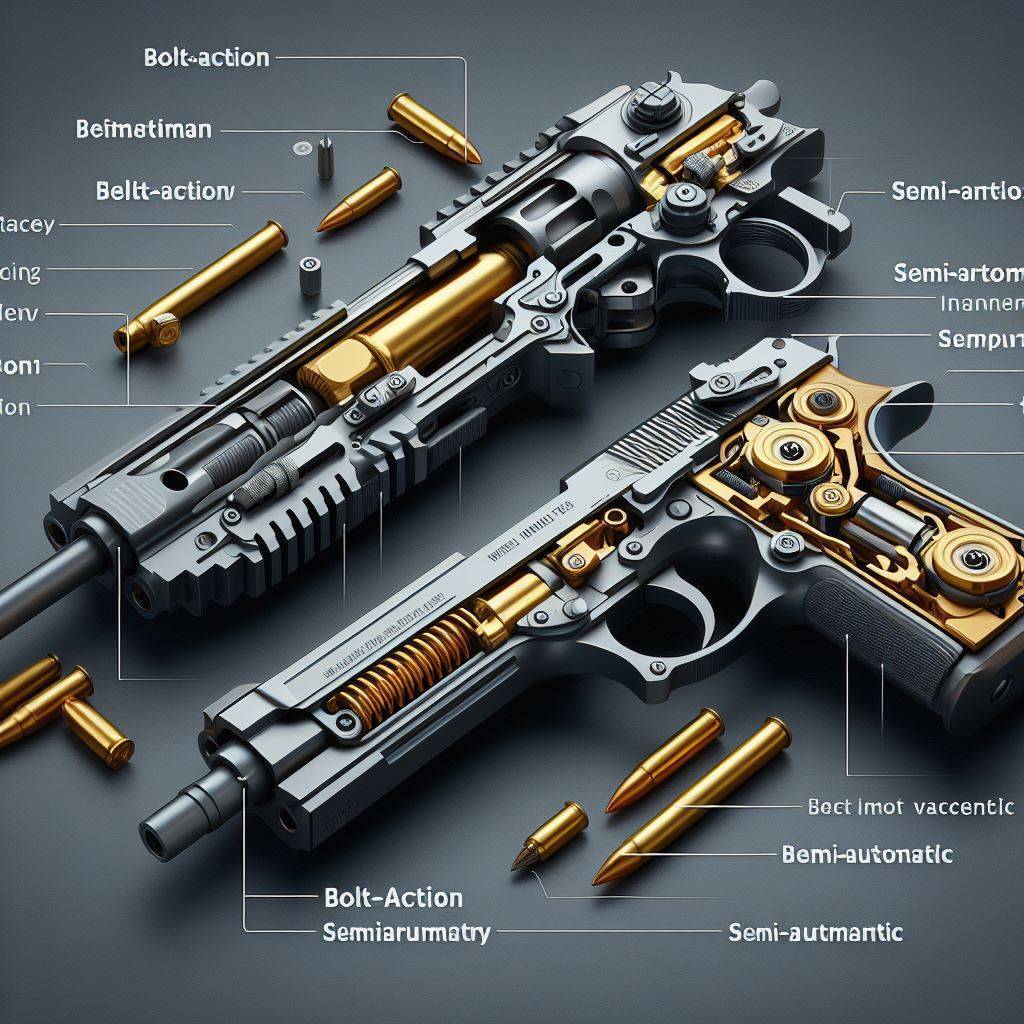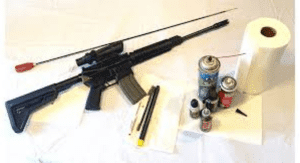The two basic styles of firearm actions are ‘Manual’ and ‘Semi-Automatic/Automatic’.
Manual actions require the shooter to manually cycle the action after each shot, typically by pulling back a bolt or pump to eject the spent cartridge and load a new one. Examples include bolt-action, pump-action, lever-action, and break-action firearms. These are often favored by hunters and precision shooters for their reliability and mechanical simplicity.
Semi-automatic and automatic actions, on the other hand, use the energy from the fired cartridge to eject the spent casing and load a new round automatically. In semi-automatic firearms, one trigger pulls fires one round, and readies the next. Automatic firearms continue to fire as long as the trigger is held down. These types of firearms are common in military, law enforcement, and self-defense situations due to their rapid-fire capability.
Firearm actions are the heart of any gun, dictating its functionality, use, and safety features. Understanding these distinctions allows for informed decisions when selecting a firearm for a specific purpose, whether it be for sport, hunting, defense, or profession.
Table of Contents
Manual Actions
Manual action firearms encompass a range of types including bolt action, lever action, pump action, and single shot. These firearms are characterized by the need for the shooter to manually manipulate the firearm to eject the used cartridge and load a new one.
Bolt Action
Bolt action rifles are a popular choice for hunting and target shooting. The user operates the bolt manually after each shot, ejecting the spent cartridge and loading the next. This type of action is known for its dependability and accuracy, making it a preferred choice for long-range shooting.
Lever Action
Lever action firearms, notably rifles, are distinguished by a lever located around the trigger guard area. After firing, the shooter uses this lever to eject the spent cartridge and load the next. Lever actions are often associated with the “Old West” and remain popular for their rapid-firing ability and historical appeal.
Pump Action
In pump action firearms, the user slides a forearm grip backward and forward to eject the spent casing and load a new one. Pump actions are frequently seen in shotguns and are well-regarded for their reliability and quick follow-up shots.
Semi-Automatic/Automatic Actions
Semi-automatic and automatic firearms use the energy of the fired cartridge to cycle the action automatically. These firearms offer rapid-fire capabilities and are common in a variety of settings from target shooting to military use.
Semi-automatic Action
A semi-automatic firearm automatically ejects the spent casing and loads the next round after each shot, but requires a separate trigger pull for each round fired. Semi-automatics offer a balance of firepower and control, making them versatile for many shooting disciplines.
Automatic Action
Automatic firearms, or machine guns, continue to fire rounds as long as the trigger is held down. These are primarily used in military and law enforcement contexts due to their high rate of fire.
In conclusion, the type of firearm action significantly influences the firearm’s functionality and usage. From the reliability and precision of manual actions to the rapid-fire capability of semi-automatic and automatic actions, each type serves its unique purpose in the world of firearms. Understanding these differences not only enriches one’s knowledge of firearms but also assists in making informed decisions when choosing a firearm for specific tasks.
Selecting the Right Firearm Action for Your Needs
Choosing the right firearm action depends on the intended use of the firearm, personal comfort, and proficiency. Each type of action has its pros and cons, and thus, understanding these is crucial to making an informed decision. Whether you’re a hunter, a sports shooter, or someone interested in self-defense, selecting the right firearm action can significantly impact your shooting experience.
Hunting
For hunting, accuracy and dependability are crucial. Manual actions, such as bolt-action or lever-action rifles, offer greater control and precision for long-range shots. Their mechanical simplicity also makes them reliable in harsh outdoor environments. However, semi-automatic actions can also be suitable for hunting game animals that require quick follow-up shots.
Target Shooting
In target shooting, precision and speed are critical factors. Manual actions, such as bolt-action rifles or single-shot firearms, offer maximum accuracy for long-distance targets. However, semi-automatic actions can also be useful in this context, especially for sports shooting competitions that require rapid-fire capabilities.
Self-Defense
When it comes to self-defense situations, rapid firepower is often a primary concern. Semi-automatic or automatic firearms allow for quick follow-up shots and are commonly used in military and law enforcement settings. However, proper training and proficiency are crucial when handling these types of actions to ensure safety.
Personal Preference
Apart from the intended use, personal comfort and proficiency with a specific type of action should also be considered when selecting a firearm. While some may prefer the simplicity and reliability of manual actions, others may feel more comfortable with the rapid-fire capabilities of semi-automatic or automatic actions. Ultimately, it is essential to choose a firearm that suits your individual needs and preferences.
Understanding the different types of firearm actions is crucial in selecting the right firearm for your specific needs. Whether you prioritize accuracy, speed, or personal comfort, there is a type of action that will suit your preferences. Remember to always prioritize safety and proper training when handling any firearm, regardless of its action type. So, it is essential to research and learn about each type before making a decision. With the right knowledge and understanding, you can confidently choose the best firearm action for your intended purpose and have an enjoyable shooting experience.
Understanding the Mechanics of Different Firearm Actions
In addition to their functionality and usage, understanding the mechanics of different firearm actions can also provide insight into how the firearm operates. Each type of action has its unique mechanism for loading and ejecting cartridges, making them distinct from one another. Knowing these differences can help you better understand your firearm and troubleshoot any potential issues that may arise during use.
Manual Actions
Manual actions, such as bolt-action and lever-action firearms, operate through the manipulation of a physical mechanism by the shooter. With bolt-action rifles, for example, the user must manually lift and pull back the bolt handle to eject the spent casing and load a new round. This repeated motion also resets the firing pin for another shot. Lever-action firearms use a similar concept but with a lever instead of a bolt handle.
Pump Action
In pump action firearms, the user must physically slide the forearm grip back and forth to cycle the action. This motion ejects the spent casing and loads a new round from the magazine tube into the chamber.
Semi-Automatic/Automatic Actions
Semi-automatic and automatic firearms use gas or recoil energy from the fired cartridge to cycle the action automatically. This process involves a series of internal mechanisms that operate in sequence to eject the spent casing, load a new round, and reset the firing pin for another shot. Understanding these complex mechanisms can help you troubleshoot any issues with your firearm’s functionality.
Bottom Line
Learning about different firearm actions not only helps us understand their functionality and usage but also provides insight into their inner workings. As responsible gun owners, it is essential to have a basic understanding of how our firearms operate to ensure safe and proper handling. With this knowledge, we can make informed decisions when selecting a firearm and know how to troubleshoot any potential issues that may arise.



